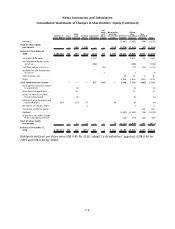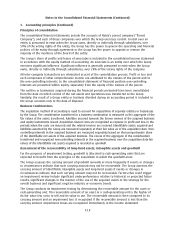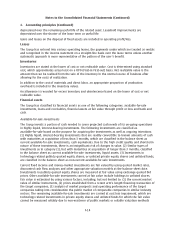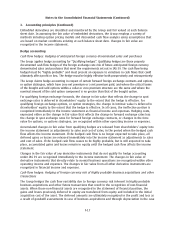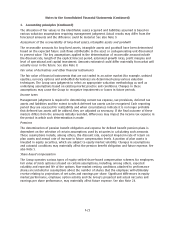Nokia 2010 Annual Report Download - page 204
Download and view the complete annual report
Please find page 204 of the 2010 Nokia annual report below. You can navigate through the pages in the report by either clicking on the pages listed below, or by using the keyword search tool below to find specific information within the annual report.1. Accounting principles (Continued)
Accounts receivable
Accounts receivable are carried at the original amount due from customers, which is considered to be
fair value, less allowances for doubtful accounts. Allowance for doubtful accounts is based on a
periodic review of all outstanding amounts, where significant doubt about collectability exists,
including an analysis of historical bad debt, customer concentrations, customer creditworthiness,
current economic trends and changes in our customer payment terms. Bad debts are written off when
identified as uncollectible, and are included within other operating expenses.
Financial liabilities
Loans payable
Loans payable are recognized initially at fair value, net of transaction costs incurred. Any difference
between the fair value and the proceeds received is recognized in profit and loss at initial recognition.
In subsequent periods, they are stated at amortized cost using the effective interest method. The long
term portion of loans payable is included on the statement of financial position under longterm
interestbearing liabilities and the current portion under current portion of longterm loans.
Accounts payable
Accounts payable are carried at the original invoiced amount, which is considered to be fair value due
to the shortterm nature of the Group’s accounts payable.
Derivative financial instruments
All derivatives are initially recognized at fair value on the date a derivative contract is entered into
and are subsequently remeasured at their fair value. The method of recognizing the resulting gain or
loss varies according to whether the derivatives are designated and qualify under hedge accounting
or not. Generally, the cash flows of a hedge are classified as cash flows from operating activities in
the consolidated statement of cash flows as the underlying hedged items relate to the company’s
operating activities. When a derivative contract is accounted for as a hedge of an identifiable position
relating to financing or investing activities, the cash flows of the contract are classified in the same
manner as the cash flows of the position being hedged.
Derivatives not designated in hedge accounting relationships carried at fair value through profit and loss
Fair values of forward rate agreements, interest rate options, futures contracts and exchange traded
options are calculated based on quoted market rates at each balance sheet date. Discounted cash
flow analyses are used to value interest rate and currency swaps. Changes in the fair value of these
contracts are recognized in the income statement.
Fair values of cash settled equity derivatives are calculated based on quoted market rates at each
balance sheet date. Changes in fair value are recognized in the income statement.
Forward foreign exchange contracts are valued at the market forward exchange rates. Changes in fair
value are measured by comparing these rates with the original contract forward rate. Currency
options are valued at each balance sheet date by using the Garman & Kohlhagen option valuation
model. Changes in the fair value on these instruments are recognized in the income statement.
For the derivatives not designated under hedge accounting but hedging identifiable exposures such
as anticipated foreign currency denominated sales and purchases, the gains and losses are recognized
within other operating income or expenses. The gains and losses on all other hedges not designated
under hedge accounting are recognized under financial income and expenses.
F16
Notes to the Consolidated Financial Statements (Continued)




